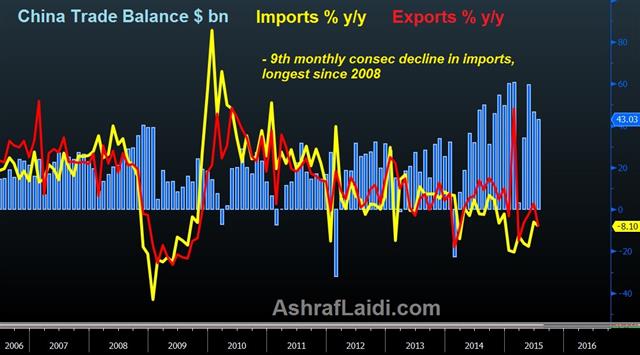PBOC Action to Further Divide the Fed
The 1.9% devaluation in the peg of the Chinese yuan is a balancing act between addressing the slowdown in exports and the economy, and stabilizing the risks of escalating capital outflows. In a nod to the IMF, China has altered the way it announces its daily fixing—the anchor price around which intraday fluctuations are permitted to move by no more than 2.0%-- by using the previous day's close instead of an arbitrary level set by the PBOC. This is no surprise to those who read us here 2 days ago.

The decision to set the daily anchor, or central rate based on the prior day's close is a an important move towards a more market-based setting, which meets a key requirement before including the yuan in the basket of the IMF's Special Drawing Right—a foreign exchange asset created by the Fund for central banks to maintain reserves in a more diversified manner.
Falling Exports, Reserves & Growth
In terms of its current account, China's slowing growth has manifested itself in the 9th consecutive monthly decline in imports (longest since 2008-9), the 5th decline in exports over the last seven months and a 7% decline in China's currency reserves to a 2-year low. The situation had especially deteriorated after the CNY rebounded in early March into early summer following the PBOC's efforts to stem any capital outflows, which arose from the 3% decline between October 2014 and March 2015.
Implications for Fed Policy
Less than 24 hours after the US dollar sustained a notable sell-off following remarks by Fed's Fisher highlighting weak inflation and throwing doubts over a September rate hike, the PBOC acted with a never-seen devaluation, which partially reversed yesterday's USD decline.The plunge in commodities- led by the 30% decline oil since May—is widely seen as a cause of disinflationary pressures. Further devaluation from Beijing could be the coup de grace for commodities, thereby exporting deflation to the US and Europe.
At a time when several FOMC members were considering a rate hike as early as next month, China's devaluation further highlights the importance of low inflation as an obstacle to Fed tightening. The decision also complicates the task of those Fed members, aiming for September liftoff but without further USD gains.
Jackson Hole will be about inflation, not jobs
Considering the disinflationary US dollar and recessionary oil/mining sector, the question to raise rates this autumn should re-emerge at the Fed's August 27-29 annual Economic Policy Symposium at Jackson Hole, where unsurprisingly the topic of this year's conference will be “Inflation Dynamics and Monetary Policy”, following last year's topic, which centered around labour markets. Fed chair Yellen will not be present at this year's conference, but the heated debated about the topic will not be absent, especially as it will take place 3 weeks days before the Sept FOMC and 7 days after the latest Greece deadline.We continue to expect no rate hike this year.
Latest IMTs
-
Only One Stock سهم واحد فقط
by Ashraf Laidi | Dec 16, 2025 19:58
-
Gold During Recessions & Bear Markets
by Ashraf Laidi | Dec 13, 2025 12:29
-
AAOI & the Fed
by Ashraf Laidi | Dec 11, 2025 19:22
-
3 Qstns for Today's Fed Meeting
by Ashraf Laidi | Dec 10, 2025 15:40
-
5 Stocks Worked for me Best in 2025
by Ashraf Laidi | Dec 5, 2025 14:42







